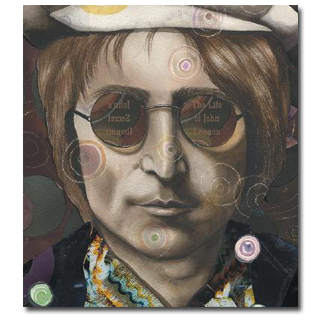
A FEW OTHER EVENTS FOR
JULY 6:
- It’s the birth date of artist Frida Kahlo (1907-1954). Read Frida by Jonah Winter, illustrated by Ana Juan; Me, Frida by Amy Novesky, illustrated by David Diaz; and Casa Azul: An Encounter with Frida Kahlo by Laban Carrick Hill.
- In 1189, Richard I (The Lionheart) is crowned King of England. Read Luke the Lionhearted by Antonie Schneider, illustrated by Cristina Kadmon.
- Happy birthday to Garrison Keillor’s radio show “A Prairie Home Companion,” which made its debut in 1974. Read Little House on the Prairie by Laura Ingalls Wilder.
- It’s National Fried Chicken Day. Read Peiling and the Chicken-Fried Christmas by Pauline Chen.
On July 6, 1957, in Saint Peter’s Parish Church in Woolton, England, a young musician performed with his band, The Quarrymen. Another young guitarist attended the event. As Elizabeth Partridge writes in John Lennon: All I Want is the Truth, the guitarist “was dressed to kill. He’d come to the garden fete hoping to pick up girls. His white sports jacket was shot through with metallic threads that sparked in the sunlight, his black drainies were tight, his hair was carefully greased back.” He arrived just in time to hear the singer of The Quarrymen break into a rendition of the Del Viking hit, “Come Go with Me.” And that is how the guitarist, Sir Paul McCartney, met John Lennon.
Lennon’s story is more often the focus of children’s and young adult books than McCartney’s. While Partridge’s John Lennon: All I Want Is the Truth has been written for fourteen- to eighteen-year-olds, in a book for children eight through ten, Doreen Rappaport explores Lennon and his songwriting in John’s Secret Dreams: The Life of John Lennon, magnificently illustrated by Bryan Collier.
The book begins and ends with Lennon’s words: “I like to write about me, because I know about me,” and “War is over, if you want it.” In the book key phrases and words from Lennon’s music form the backdrop, the accompaniment as it were, to the details of his life. Born in the Penny Lane district of Liverpool, raised by his aunt and uncle, the bright young boy got swept up in the rock and roll movement that was taking America by storm. Lennon and McCartney brought in two other performers, Ringo Starr on drums, and George Harrison on guitar, to form the Beatles. By the age of twenty-four Lennon and this group had gone to the top of the charts, again and again.
Rappaport deals very honestly about the details of Lennon’s life—his drug use, leaving his wife for Yoko Ono, and the pressures of being so famous at such a young age. And it says simply: “John Lennon was murdered when he was only forty years old.” Bryan Collier’s collages, which rely largely on circle compositions, bring both the images and words of John Lennon to life.
Grandparents, who may well have seen the Beatles on the Ed Sullivan Show, might want to share this book with their grandchildren. It can be used to explain the question: Who were the Beatles? Their journey began fifty-four years ago when John Lennon met Paul McCartney.
Here’s a page from John’s Secret Dreams: The Life of John Lennon:
Originally posted July 6, 2011. Updated for .







Always a suprise what book will be writen up. I love it when they are rare. Thanks for intoducing me to another picture book I did not know about!
What a combination: John Lennon, Doreen Rappaport, and Bryan Collier! How could this book not be great? Thanks, Anita.
Doreen Rappaport makes a fabulous combined author/genre study in grades 3-5. John’s Secret Dreams is one of five of her biographies that are written in a very similar style. In doing this study with children, we focus on Rappaport’s craft. Using a keystone text, Martin’s Big Words, each day we studied a new craft technique. For example, one day we explored Rappaport’s use of quotes in her texts. Students then independently selected one of her other biographies (of which John’s Big Words was a beloved text) and explored the quotations. Students then met in small book groups to discuss their independent text and role that quotations played. At the conclusion of our unit in Writer’s Workshop, students then learned how to use those biographical craft techniques and wrote their own biographies of a family member. Because of Rapport’s incredible ability to spin a poetic tale and her illustrators (like Collier) consistency to create page turning collages and drawings, this unit was highly engaging and a clear favorite of students.
Matt: Thanks for the information on how you used Rappaport in an author study. I know many teachers are now hunting for quality nonfiction authors and titles to meet the Common Core standards. All of Rappaport’s work is worth studying for those purposes — and just to enjoy as well-written books.